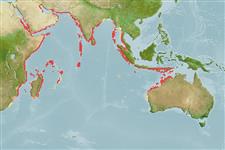Environment: milieu / climate zone / depth range / distribution range
Οικολογία
Θαλασσινό(ά) Υφαλόφιλο(α); εύρος βάθους 8 - 25 m (Ref. 90102). Tropical
Western Indian Ocean.
Μέγεθος / Βάρος / Age
Maturity: Lm ? range ? - ? cm
Max length : 20.0 cm TL αρσενικό/απροσδιόριστο; (Ref. 11441)
Ραχιαίες άκανθες (συνολικά): 5; Μαλακές ραχιαίες ακτίνες (συνολικά): 21; Εδρικές άκανθες 1; Μαλακές εδρικές ακτίνες: 17; Σπόνδυλοι: 30. This species is distinguished by the following characters: body color in life light brown dorsally, center of scales whitish, 6 irregular, semicircular brown blotches along back that link narrowly to large dark brown spots on about lower 2/3 of body, with the spots vertically elongate anteriorly, horizontally elongate and darker posteriorly; head orangish brown with small dark brown spots dorsally on snout and nape, 7 narrow bluish white bars (3 on opercle and preopercle, 4 radiating from ventral and anterior part of eye); dorsal and anal fins are translucent whitish, the spinous dorsal with a large black basal spot mainly between the 3rd and 5th spines; rows or round orange spots on soft dorsal fin; small irregular white spots on anal fin; dark brown about lower third of caudal fin with small whitish spots along rays, the rest of the fin light grey with small white and orange spots along rays; D V,21, all rays branched; A I,17 all rays branched; pectoral rays 16-17, branched except uppermost; 57-58 lateral line scales; gill rakers 4-6 + 8-10; lower jaw projecting, 3 pairs of canine teeth anteriorly in jaws; palatine teeth absent; vomerine teeth in a chevron-shaped patch of 3-4 rows; greatest body depth 5.05-6 in SL; head length (HL) 3.5-3.9 in SL; orbit diameter 3.6-4.4 in HL; preopercle's posterior margin with widely spaced, small, blunt serrae; opercle scales ctenoid, cheek scales weakly ctenoid dorsally, becoming cycloid, progressively smaller, nonimbricate ventrally; fourth dorsal spine is the longest, 3.1-3.8 in HL; caudal fin emarginate on dorsal half, often with protruding upper lobe, becoming rounded on ventral half; pectoral fins 5.1-5.4 in SL; pelvic fins just reaching anus (Ref. 79876).
Coastal species found in shallow estuaries and protected coastal bays to depths of about 25 m (Ref. 48636). Inhabit sand bottoms solitarily (Ref. 90102). Minimum depth reported from Ref. 48636.
Life cycle and mating behavior
Γεννητική Ωρίμανση | Αναπαραγωγή | Γεννοβολία | Αβγά | Γονιμότητα | Προνύμφες
Randall, J.E., 2008. Six new sandperches of the genus Parapercis from the Western Pacific, with description of a neotype for P. maculata (bloch and Schneider). The Raffles Bull. Zool. 19:159-178. (Ref. 79876)
IUCN Red List Status (Ref. 130435)
Threat to humans
Harmless
Human uses
Περισσότερες πληροφορίες
Κοινά ονόματαΣυνώνυμαΜεταβολισμόςΘηρευτέςΟικοτοξικολογίαΑναπαραγωγήΓεννητική ΩρίμανσηΓεννοβολίαΣυναθροίσεις γεννοβολίαςΓονιμότηταΑβγάEgg development
ΑναφορέςΥδατοκαλλιέργειεςΠροφίλ υδατοκαλλιέργειαςΣτελέχοιΓενετικήElectrophoresesΚληρονομικότηταΑσθένειεςΜεταποίησηNutrientsMass conversion
ΣυνεργάτεςΦωτογραφίεςStamps, Coins Misc.ΉχοιΣιγκουατέραΤαχύτηταΚολυμβητικός ΤύποςΕπιφάνεια βραγχίωνOtolithsΕγκέφαλοιΌραση
Εργαλεία
Special reports
Download XML
Διαδικτυακές πηγές
Estimates based on models
Preferred temperature (Ref.
123201): 26.3 - 29.3, mean 28.3 °C (based on 1011 cells).
Phylogenetic diversity index (Ref.
82804): PD
50 = 0.5000 [Uniqueness, from 0.5 = low to 2.0 = high].
Bayesian length-weight: a=0.00692 (0.00311 - 0.01538), b=3.06 (2.88 - 3.24), in cm total length, based on LWR estimates for this Genus-body shape (Ref.
93245).
Τροφικό Επίπεδο (Ref.
69278): 3.5 ±0.4 se; based on size and trophs of closest relatives
Ελαστικότητα (Ref.
120179): Υψηλό, ελάχιστος χρόνος για διπλασιασμό πληθυσμού < 15 μήνες (Preliminary K or Fecundity.).
Fishing Vulnerability (Ref.
59153): Low vulnerability (10 of 100).
